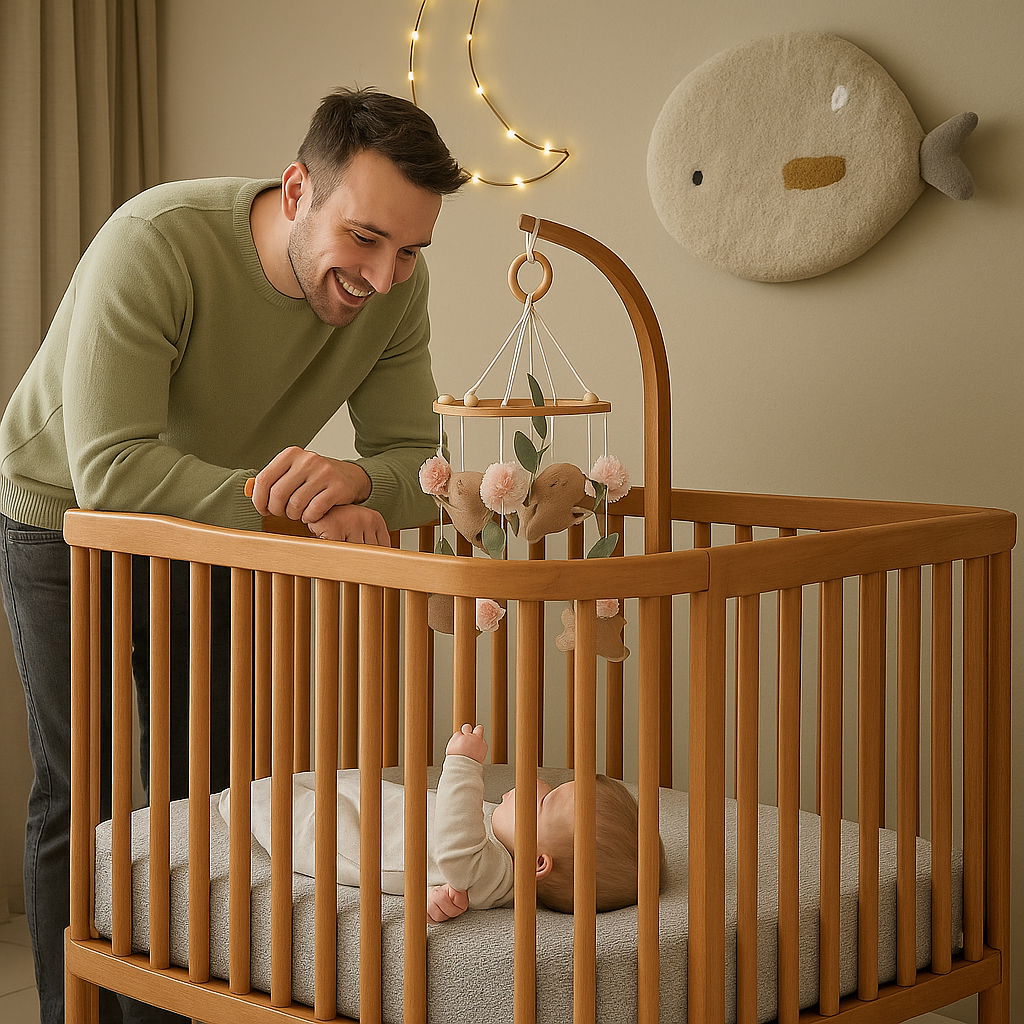When Should You Remove the Baby Crib Mobile? Pediatrician Guidelines Explained 🍼
Welcoming a new baby into your home means creating the perfect nursery environment filled with love, comfort, and safety. Among the most cherished nursery accessories, crib mobiles hold a special place in parents' hearts 💕. These delightful developmental tools provide essential visual stimulation and auditory development benefits during your baby's earliest months. However, as your little one grows and reaches important developmental milestones, knowing when to take down mobile becomes a critical safety consideration that every parent must understand.
The Magic of Crib Mobiles in Early Development ✨
During baby's first months, crib mobiles serve as incredible developmental tools that support your infant's growing mind and senses. These creative nursery decor pieces aren't just pretty decorations – they're carefully designed instruments that promote crucial early learning experiences.
Visual Development Benefits 👀 High-contrast designs in mobiles provide the perfect level of visual stimulation for newborns, whose eyesight is still developing. The gentle movement of hanging elements helps babies develop essential baby tracking skills as they learn to follow objects with their eyes. This visual coordination practice lays the foundation for future hand-eye coordination and spatial awareness.
Auditory Growth Support 🎵 Many mobiles feature soothing melodies that contribute to auditory development while establishing a calming bedtime routine. These gentle sounds help babies distinguish different tones and rhythms, supporting their developing hearing abilities. The combination of visual and auditory elements creates a multi-sensory experience that promotes healthy sensory growth.
Sleep and Comfort Associations 😴 Mobiles often become integral parts of bedtime routines, with their familiar melodies and gentle movements signaling sleep time to your baby. This association between the mobile and rest helps establish healthy sleep patterns during those crucial early months when building good sleep habits is essential.
Understanding Crib Mobile Safety Guidelines 🛡️
While crib mobile benefits are numerous during the early months, understanding when to remove baby crib mobile is crucial for maintaining infant safety. Pediatricians universally emphasize that safety must always take precedence over developmental benefits as your baby grows stronger and more mobile.
The Critical 5-Month Mark 📅 The mobile starts to present a safety hazard when Baby is around 5 months or whenever they start sitting up, as they begin getting close to being able to reach up and grab things. This timeline aligns perfectly with most babies' developmental progression, though every child develops at their own unique pace.
Why This Timeline Matters ⚠️ As babies approach the 5-6 month mark, they experience rapid physical development that transforms them from passive observers to active explorers. Their arm strength increases significantly, their coordination improves, and their curiosity drives them to reach for and grab everything within their expanding range.
Key Signs to Remove Mobile: What to Watch For 👁️
Recognizing the signs to remove mobile requires careful observation of your baby's developmental milestones and behavioral changes. Here are the critical indicators that it's time to make this important transition:
Physical Development Red Flags 🚨
- Baby sitting up independently: Once your little one can sit without support, they're dangerously close to being able to reach the mobile
- Baby pulling up to standing: This milestone dramatically increases their reach and potential for grabbing hanging objects
- Improved reaching abilities: Watch for deliberate attempts to reach toward the mobile or other hanging objects
- Enhanced baby tracking skills: When babies can smoothly follow moving objects with their eyes, they're also developing the coordination to grab them
- Strengthened arm and shoulder muscles: Increased upper body strength means greater reaching capability
Behavioral Changes to Monitor 🔍
- Baby loses interest in the mobile: Decreased fascination often indicates they're ready for more interactive stimulation
- Attempts to grab or touch: Any reaching behavior toward the mobile signals immediate removal is necessary
- Fussiness when mobile isn't moving: This might indicate they want more interactive engagement
- Focus shifting to other interactive toys: When babies prefer toys they can manipulate, the mobile's passive entertainment value diminishes
The Science Behind Mobile Height Recommendations 📏
Understanding mobile height recommendations helps parents maximize benefits while maintaining safety. The ideal positioning places mobiles 12-16 inches above the mattress surface – close enough to provide visual engagement but far enough to prevent reaching during the early months.
Safe Mounting Guidelines 🔧 Proper installation requires secure mounting that can withstand any potential pulling or grabbing. All components should be regularly inspected for wear, loose parts, or damage that could create choking hazards. The mobile should be positioned away from crib sides to prevent any possibility of entanglement.
Monitoring Baby Reactions 👶 Throughout the mobile's usage period, parents should continuously observe their baby's reactions. Positive engagement includes calm attention, gentle cooing, and peaceful sleep associations. However, if the mobile becomes overstimulating or causes distress, adjustments or early removal might be necessary.
Creating a Safe Nursery Environment Beyond the Mobile 🏠
Maintaining a safe nursery environment extends far beyond mobile removal. As your baby grows, every element in their sleep space requires regular evaluation for age-appropriate safety.
Bedding Guidelines Evolution 🛏️ As babies develop increased mobility, bedding guidelines also evolve. What's safe for a newborn may pose risks for a sitting, rolling, or pulling-up baby. Regular assessment ensures your nursery grows safely alongside your child.
Alternative Developmental Tools 🧸 The transition from mobile doesn't mean ending developmental support. Age-appropriate alternatives include:
- Gentle nightlight projectors: Provide visual interest without reachable parts
- Textured sensory books: Support tactile development and visual engagement
- Safe, grabbable crib toys: Satisfy the urge to touch and explore
- Musical toys with secure attachment: Continue auditory stimulation safely
The Transition Process: Making It Smooth 🌟
When removing mobile tips indicate it's time for change, planning a smooth transition helps maintain your baby's comfort and routine.
Timing the Removal ⏰ Choose a time when your baby is well-rested and content. Avoid removal during periods of illness, teething, or other disruptions that might make the change more challenging.
Gradual vs. Immediate Removal 🔄 Some parents prefer gradual removal, perhaps starting with turning off music while leaving visual elements, then removing the mobile entirely. Others find immediate removal works better. Choose the approach that feels right for your family.
Maintaining Sleep Associations 😇 If your baby has strong sleep associations with the mobile, prepare alternative comfort strategies. This might include introducing a lovey, adjusting room lighting, or establishing new bedtime music routines.
Repurposing Mobile: Creative Second Lives 🎨
Repurposing mobile elements extends their value beyond the nursery period. Creative parents find numerous ways to continue enjoying these special pieces:
Wall-Mounted Decoration 🖼️ Transform the mobile into beautiful wall art that continues adding visual interest to the nursery without safety concerns.
Playroom Entertainment 🎪 Hanging mobiles in play areas where older babies and toddlers can safely enjoy them during supervised play creates continued engagement opportunities.
Keepsake Transformation 💝 Some parents preserve mobile elements in shadow boxes or photo displays, creating lasting memories of their baby's earliest months.
Long-Term Developmental Considerations 🌱
Understanding developmental stages and mobiles helps parents appreciate how this early tool fits into their child's broader learning journey. The visual tracking, focus development, and sensory integration supported by mobiles during early months create foundations for future learning skills.
Supporting Continued Growth 📈 After mobile removal, focus shifts to interactive toys that support developing motor skills, cognitive abilities, and social engagement. The progression from passive observation to active manipulation represents healthy developmental advancement.
Expert Recommendations and Final Thoughts 👨⚕️
Pediatricians emphasize that when to stop using mobiles depends on individual developmental timelines rather than strict chronological age. While 5-6 months serves as a general guideline, parents should prioritize their own baby's demonstrated abilities and safety needs.
The effect of mobiles on sleep and development varies among children, but research consistently supports their value during appropriate developmental windows. The key lies in recognizing when these benefits transition into potential risks.
Remember, removing your baby's mobile represents a positive milestone in their growth and development 🎉. This transition opens doors to new learning opportunities and reflects your child's increasing capabilities and curiosity about their world.
By following these pediatrician guidelines and remaining attentive to your baby's individual needs, you're providing the safest possible environment while supporting their continued healthy development. Trust your parental instincts, prioritize safety above all else, and celebrate each developmental milestone as your little one grows! 👑




Leave a comment
This site is protected by hCaptcha and the hCaptcha Privacy Policy and Terms of Service apply.